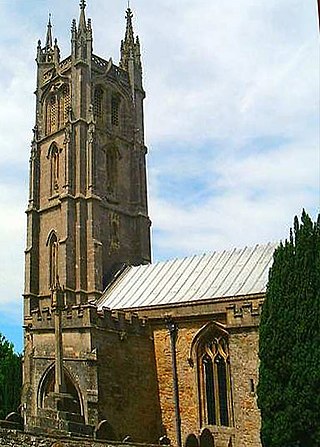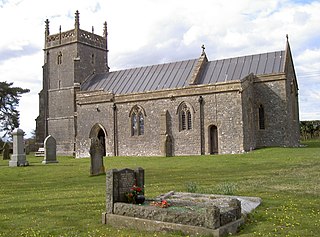
Winsham is a village and civil parish 4 miles (6 km) south-east of Chard and 6 miles (10 km) from Crewkerne, in the South Somerset district of Somerset, England. The parish, which has a population of approximately 750 residents living in some 335 households, includes the hamlets of Whatley, Bridge, Purtington and Ammerham, and covers an area of approximately 12 square miles (3,100 ha).

St Andrew's Church is an Anglican church in Backwell, Somerset, England. The church building dates back to the 13thcentury, when the nave, aisles and the chancel were built. The church was subsequently altered and enlarged during the 14th to 17th centuries; the 31m-high west tower dates from the 15th century, and the rood screen is from the early 16th century. The church has been a Grade I listed building since 1961.

The Church of St Andrew & St Mary in Pitminster, Somerset, England was built around 1300 and has been designated as a Grade I listed building.

The Anglican Church of St Lawrence at Priddy, Somerset, England, dates from the 13th century, with some rebuilding in the 15th century and was restored in 1881–88; it is a Grade I listed building.

The Church of St Julian in Wellow, Somerset, England has origins before the 12th century although the present building dates from 1372. It has been designated as a Grade I listed building.

The Church of All Saints is an Anglican church in Norton Fitzwarren, Somerset, England, which dates from the late 13th or early 14th century. It is located in the deanery of Taunton, within the diocese of Bath and Wells. It is a Grade II* listed building.

The Anglican Church of St Michael and All Angels at Butcombe in the English county of Somerset was built in the 15th century and restored in 1868. It is a Grade II* listed building.

The Norman Anglican Church of St Giles in Thurloxton dates from the 14th century but is predominantly from the 15th century with 19th-century restoration including the addition of the north aisle in 1868. It has been designated by English Heritage as a Grade II* listed building.

The Anglican Church of St Peter and St Paul at Runnington in Langford Budville, Somerset, England was built in the 15th century. It is a Grade II* listed building.

The Anglican Church of St Michael in Minehead, Somerset, England was built in the 15th century. It is a Grade II* listed building.

The Anglican Church of St Mary in Brompton Ralph, Somerset, England was built in the 15th century. It is a Grade II* listed building.

The Anglican Church of the Blessed Virgin Mary in Ashill, Somerset, England was built in the 12th century. It is a Grade II* listed building.

The Anglican Church of St Mary in Compton Pauncefoot, Somerset, England was built in the 15th century. It is a Grade II* listed building.

The Anglican Church of St Mary in Yarlington, Somerset, England was built in the 11th century. It is a Grade II* listed building.

The Anglican Church of St Mary Major in Ilchester, Somerset, England was built in the 13th century. It is a Grade II* listed building.

The Anglican Church of St Michael in Seavington St Michael, Somerset, England was built in the 12th century. It is a Grade II* listed building.

The Anglican Church of St John the Baptist in Horsington, Somerset, England was built in the 15th century and rebuilt between 1885 and 1887. It is a Grade II* listed building.

The Church of St Thomas à Becket is the Anglican parish church for the ancient village of South Cadbury in Somerset and is dedicated to Thomas Becket. Today it is one of the 'Camelot Churches' of South Somerset in the Diocese of Bath and Wells and has been a Grade II* listed building since 1961. The church was much restored in the 1850s and 1870s.

The Anglican Church of St David in Barton St David, Somerset, England, was built in the 12th to 15th centuries. It is a Grade II* listed building.

The Anglican Church of St Nicholas in Holton, Somerset, England was built in the 14th century. It is a Grade II* listed building.





















